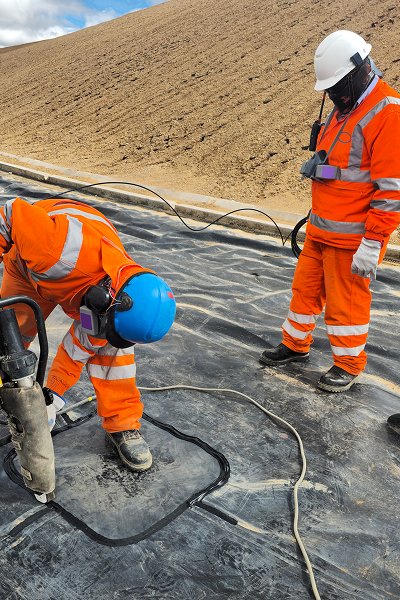What is Woven Geotextile?
Woven geotextile is a flat geosynthetic material made of high-strength synthetic fibers (such as polypropylene PP or polyester PET) arranged crosswise by weaving. Its typical structure is that the longitudinal and transverse fibers are regularly crossed to form a grid-like fabric surface, which has good mechanical properties and stability.

Main features:
Tight structure: warp and weft yarns are interwoven to form smaller pores;
High strength: has strong tensile and tear resistance;
Strong corrosion resistance: chemical corrosion resistance and mildew resistance;
Limited permeability: small pores, water can penetrate but the flow rate is slow.
Structural characteristics of woven geotextiles Permeability
Porosity formed by woven structure
Although the structure of woven geotextiles is tight, there are tiny pores between the intersections of warp and weft, and these pores are the key to whether water can penetrate.
Pore characteristics:
The pore size is usually 0.05~0.5mm
The structure is stable and not easy to collapse due to load
The drainage path is relatively straight, and the water filtration performance depends on the pore size and fabric thickness
Parameters affecting permeability
Porosity (O90/O95): indicates the pore size through which 90%/95% of particles can pass;
Permittivity: reflects the permeability per unit area under unit pressure;
Thickness: The thicker the thickness, the longer the permeability path;
Tension state: The pore size will change after being pulled, affecting the permeability.
Engineering uses of woven geotextiles
Road reinforcement and isolation
Water seepage is mainly through lateral drainage, and the woven fabric plays the role of isolation + reinforcement;
Minor water seepage does not affect the overall structural function.
Water conservancy project filter layer
It can be used as an anti-erosion and primary filter layer in water retaining dams, slope protection, and drainage ditches;
It is usually used with filter layer soil or non-woven fabrics to enhance the overall permeability.
Landfill liner
Woven fabrics are mostly used for lower support and protection;
The upper part is HDPE membrane and non-woven fabric to form the main drainage layer, reducing dependence on its permeability.
Railway roadbed isolation
Prevent the mixing of upper and lower soils and maintain structural stability;
Water is led away by the side or drainage pipes, and does not rely on its permeability function.


Ways to improve the permeability of woven geotextiles
Choose appropriate aperture design
For projects that require higher water permeability, products with slightly larger apertures can be selected;
Control the range where soil particles cannot pass but water can penetrate.
Multi-layer composite structure
Often composited with non-woven geotextiles, combining strength and filterability;
For example: composite geotextile with one woven fabric + one needle-punched fabric.
Avoid clogging
During construction, care should be taken to prevent mud and sand from directly pressing the surface;
Add a filter sand layer or non-woven fabric layer.
Misunderstanding
Woven geotextile is an impermeable material
Wrong understanding: Due to its dense weaving structure, many people think that woven geotextile is completely impermeable, and even use it as a similar waterproof membrane.
Correct explanation:
Woven geotextile is indeed not as permeable as non-woven geotextile, but it still has a certain permeability. There are tiny pores between its warp and weft yarns, which can allow water to pass through under the action of water pressure, especially in foundation drainage and drainage between roadbed layers, and can still play the role of primary water filtration or slow infiltration.
Woven geotextile can be used as the main drainage layer material
Wrong understanding: Some design schemes directly use woven fabrics as drainage layers, believing that they are strong and economical, and can replace drainage nets or non-woven fabrics.
Correct explanation:
The permeability rate of woven geotextiles is relatively low, and it is not suitable for use as the main drainage layer alone. In situations where rapid water conduction and continuous drainage are required (such as basement drainage, landfill leachate system, etc.), it is recommended to use drainage boards, drainage nets or highly permeable non-woven geotextiles. Woven fabrics are more suitable for structural reinforcement, soil isolation or auxiliary water filtration in the system.
The pores of woven fabrics remain unchanged and the permeability is stable for a long time
Misunderstanding: Some people believe that as long as the laboratory test is qualified, the water permeability of geotextiles will remain the same in field use.
Correct explanation:
In actual applications, the pores of woven geotextiles may change due to sedimentation, blockage, soil particle intrusion, etc. Especially in areas with high clay content and mud content, its pores are easily blocked by particles, resulting in a decrease in water permeability. Therefore, when designing, it is necessary to consider the design of the filter layer or the use of other materials in combination to prevent blockage.


